Rutherford scattering - Study guides, Class notes & Summaries
Looking for the best study guides, study notes and summaries about Rutherford scattering? On this page you'll find 41 study documents about Rutherford scattering.
Page 3 out of 41 results
Sort by
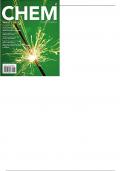
-
CHEM2 Chemistry in Your World 2nd Edition by Hogg - Test Bank
- Exam (elaborations) • 209 pages • 2023
- Available in package deal
-
- $33.13
- + learn more
Chapter 1—Living in a World of Chemistry MULTIPLE CHOICE 1. Which activity comes first in the scientific method? a. conclusion b. hypothesis c. experimentation d. observation ANS: D 2. Which is considered a physical science? a. physics b. biology c. zoology d. botany ANS: A 3. A scientist is trying to make a new insecticide that will be more toxic to flies, but less toxic to humans than insecticides now available. The scientist is engaged in a. basic research. b. applied research. ...
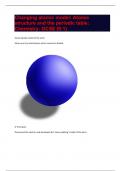
-
Changing atomic model: Atomic structure and the periodic table: Chemistry: GCSE (9:1)
- Exam (elaborations) • 7 pages • 2024
-
- $10.99
- + learn more
Ancient greek model of the atom Atoms are tiny solid spheres which cannot be divided. JJ Thompson Discovered the electron and developed the "plum-pudding" model of the atom plum pudding model of the atom atoms are balls of positively charge with negative electrons embedded in it Rutherford, Geiger, and Marsden carried out the alpha particle scattering experiment and developed the nuclear model of the atom Alpha particle scattering experiment Fired alpha particles at a thin sheet of go...

-
AQA GCSE Chemistry - History of the Atom
- Exam (elaborations) • 2 pages • 2024
- Available in package deal
-
- $11.64
- + learn more
AQA GCSE Chemistry - History of the Atom 1. What is the term used to describe the number of protons present in an atom? Answer: The atomic number. 2. What is the number of electrons in an atom related to? Answer: The number of protons. 3. How do you calculate the number of neutrons in an atom? Answer: By subtracting the atomic number from the atomic mass number. 4. Who described atoms as solid spheres in the 19th century? Answer: John Dalton. 5. What discovery by JJ Thomson led...
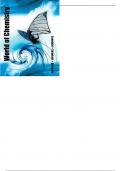
-
WORLD OF CHEMISTRY 3RD EDITION By STEVEN S. ZUMDAHL - Test Bank
- Exam (elaborations) • 284 pages • 2023
-
- $22.73
- + learn more
CHAPTER 3: Chemical Foundations: Elements, Atoms, and Ions 1. What is the most abundant element on the Earth (including the crust, oceans, and atmosphere)? A. silicon B. oxygen C. hydrogen D. iron E. carbon ANS: B PTS: 1 TOP: Test: Chapter Test NOT: worldofchem_2013 2. What is the most abundant element found in the human body? A. oxygen B. water C. hydrogen D. calcium E. carbon ANS: A PTS: 1 TOP: Test: Chapter Test NOT: worldofchem_2013 3. The symb...
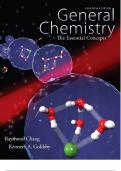
-
Test Bank For General Chemistry The Essential Concept 7Th Edition Raymond By Chang
- Exam (elaborations) • 398 pages • 2023
- Available in package deal
-
- $33.13
- + learn more
Chapter 01: Introduction 1. A tentative explanation for a set of observations that can be tested by further experimentation is referred to as A) a hypothesis. B) a law. C) a theory. D) none of the above. Ans: A Category: Easy Section: 1.2 2. A concise verbal or mathematical statement of a relationship between phenomena that is always the same under the same conditions is referred to as A) a hypothesis. B) a law. C) a theory. D) none of the above. Ans: B Category: Easy Section: 1.2 3. A un...

-
Test Bank For CHEM2 Chemistry in Your World 2nd Edition by Hogg
- Exam (elaborations) • 208 pages • 2023
-
- $31.83
- + learn more
Chapter 3—Atoms and the Periodic Table MULTIPLE CHOICE 1. Which combination of individual and contribution is not correct? a. Antoine Lavoisier - clarified confusion over cause of burning b. John Dalton - proposed atomic theory c. Marie Curie - discovered radium and polonium d. Robert Millikan - discovered the neutron ANS: D 2. John Dalton did his research work in which of the following countries? a. France b. Greece c. Russia d. England ANS: D 3. Which radiation type has no detect...
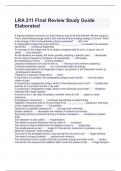
-
LRA 211 Final Review Study Guide
- Exam (elaborations) • 3 pages • 2024
-
- $11.49
- + learn more
LRA 211 Final Review Study Guide Elaborated A filament electron removes a K shell electron and an M shell electron fills the vacancy. The K shell binding energy is 69.5 keV and the M shell binding energy is 2.8 keV. What is the energy of the K-characteristic photon produced? - 66.7 keV A radiographic image that is too light has ________________ to visualize the anatomic structures. - excessive brightness An increase in the image size of an object compared with its true, or actua...
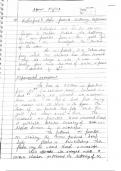
-
Class notes Atomic Physics
- Class notes • 31 pages • 2024
-
- $20.49
- + learn more
Rutherford Alpha particles scattering experiment -Experiment arrangement, Observation, Explanation, Conclusion.Rutherford's atom model.Drawbacks of Rutherford 's Atom model. Electric orbits.Bohr's model of Hydrogen atom.Expression for orbital velocity of Electron.Expression for Radius of the orbit . Expression for total energy of electron.Bohrs theory of Hydrogen spectra. Line spectra of hydrogen - Explanation based on Bohr's theory. Energy level diagram of hydrogen atom.
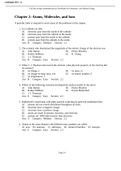
-
Chemistry 11th Edition Chang Helpful Unhelpful
- Exam (elaborations) • 18 pages • 2022
-
- $10.99
- + learn more
Chapter 2: Atoms, Molecules, and IonsIn a cathode ray tube A) electrons pass from the anode to the cathode. B) electrons pass from the cathode to the anode. C) protons pass from the anode to the cathode. D) protons pass from the cathode to the anodeThe scientist who determined the magnitude of the electric charge of the electron was A) John Dalton. D) Henry Moseley. B) Robert Millikan. E) R. Chang. C) J. J. ThomsonWhen J. J. Thomson discovered the electron, what physical property of the electron...
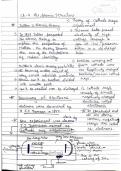
-
Full explanation of atomic structure
- Summary • 6 pages • 2024
-
- $9.49
- + learn more
Discovery of protons, neutrons , electrons , goldfoil alpha particle scattering experiment, arrangement of electrons in atom, discrimination of nucleus, protons and atomic number , jj Thomson atom model , Bohr s atom model , Rutherford model , Goldstein model , drawback of all atoms , distribution of all electrons in all shells , meaning of p =n , p=n=z , mass number , observation of all models , conclusion of all models , Bohr and bury

How much did you already spend on Stuvia? Imagine there are plenty more of you out there paying for study notes, but this time YOU are the seller. Ka-ching! Discover all about earning on Stuvia


